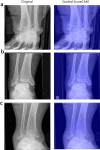Development of a deep learning algorithm for radiographic detection of syndesmotic instability in ankle fractures with intraoperative validation
- PMID: 40813443
- PMCID: PMC12354714
- DOI: 10.1038/s41598-025-14604-w
Development of a deep learning algorithm for radiographic detection of syndesmotic instability in ankle fractures with intraoperative validation
Abstract
Identifying syndesmotic instability in ankle fractures using conventional radiographs is still a major challenge. In this study we trained a convolutional neural network (CNN) to classify the fracture utilizing the AO-classification (AO-44 A/B/C) and to simultaneously detect syndesmosis instability in the conventional radiograph by leveraging the intraoperative stress testing as the gold standard. In this retrospective exploratory study we identified 700 patients with rotational ankle fractures at a university hospital from 2019 to 2024, from whom 1588 digital radiographs were extracted to train, validate, and test a CNN. Radiographs were classified based on the therapy-decisive gold standard of the intraoperative hook-test and the preoperatively determined AO-classification from the surgical report. To perform internal validation and quality control, the algorithm results were visualized using Guided Score Class activation maps (GSCAM).The AO44-classification sensitivity over all subclasses was 91%. Furthermore, the syndesmosis instability could be identified with a sensitivity of 0.84 (95% confidence interval (CI) 0.78, 0.92) and specificity 0.8 (95% CI 0.67, 0.9). Consistent visualization results were obtained from the GSCAMs. The integration of an explainable deep-learning algorithm, trained on an intraoperative gold standard showed a 0.84 sensitivity for syndesmotic stability testing. Thus, providing clinically interpretable outputs, suggesting potential for enhanced preoperative decision-making in complex ankle trauma.
© 2025. The Author(s).
Conflict of interest statement
Declarations. Competing interests: The authors declare no competing interests. Ethical considerations: The study protocol was approved by the FAU Ethics Review Committee at Friedrich Alexander University approved our study (approval: 23-173-Br) in 05/2023 and the requirement for informed consent was waived owing to the retrospective design of our study.
Figures






References
-
- Mandi, D. M. Ankle fractures. Clin. Podiatr. Med. Surg.29(2), 155–186 (2012). - PubMed
-
- Cornu, O. et al. Traumatic injuries of the distal tibiofibular syndesmosis. Orthop. Traumatol. Surg. Res.107(1, Supplement), 102778 (2021). - PubMed
-
- Carlucci, S. et al. Syndesmosis injury associated with high-energy tibial shaft fractures: Case series of a misdiagnosis rupture. Rev. Esp. Cir. Ortop. Traumatol.66(4), 274–280 (2022). - PubMed
MeSH terms
LinkOut - more resources
Full Text Sources
Medical

